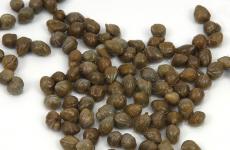White house fungus - methods of destruction. Mold and mildew are the main enemies of a wooden house
The appearance of house fungus on wooden structures always upsets and upsets household members. However, if you do not attach importance to this, then soon it will become not only a reason for a bad mood, but also a cause of destruction of products even from the most durable types of wood, and most importantly, a source of dangerous diseases.
In order to find out how to destroy house fungus, you should first figure out what exactly you are faced with: basement fungus, house sponge or white house fungus. You can detect the enemy with the naked eye. White and yellow spots on wooden surfaces, which darken to brown and black over time, indicate that a basement fungus has settled in your room. The house sponge covers the wood with a white layer, similar to a shroud of cotton wool, and can grow up to 10 m. A similar white porous cushion is also left by the white house fungus.
You should insure yourself against this misfortune even at the construction stage. Never build with damp, poorly dried, or used wood. Impregnation of wooden elements with special oils and preparations, such as creazote, will serve as an excellent preventive measure against fungus.
If, despite all your efforts, you still encounter this problem, then the best way The solution will be to completely replace the fungus-damaged areas of the structures. The truth is like this radical method not always accessible and easy. An alternative would be to scrape the fungus from the affected area and treat the surface with a special solution based on copper or iron sulfate.
Here are several types of solutions and mixtures that can give maximum effect in the fight against house fungus:
liter of water, 50 g of vitriol, clay;
10 liters of water, 500 g of vitriol, 2 tablespoons of vinegar;
liter of water, 100 g of sodium fluoride;
You can, of course, find ready-made mixtures for killing fungus. In any case, they can be applied either by spraying or using a brush.
Just in case, repeat the treatment in a month. Do not forget to regularly ventilate the premises and periodically repaint the wooden structural elements and house fungus will no longer bother you.



A rotten tree is found in a wooden house - the decisive question arises: was it a real house mushroom (Serpula lacrymans) or not? The reaction is more than correct, because after the cause of the lesion has been clarified, you can begin to eliminate it.
By the way, elimination methods vary greatly depending on the type of pathogen. If you live in a log house or are planning to build one, this information may be useful to you.
Forewarned is forearmed!
Real house mushroom
Defeat real house mushroom is usually accompanied by deep growth into stone walls and other mineral building materials, which makes thorough remediation a truly expensive undertaking.

All other wood fungi do not have such a pronounced all-germinating ability, so for treatment it would be enough to simply replace the infected beams and eliminate the problem of high moisture content in the wood.
Only in isolated cases of germination into mineral elements of a building would additional chemical treatment be required.
Determining the type of fungal pathogen to exclude the true house fungus and related species of other wood-destroying fungi is mandatory, since according to GOST 20022.1-90 “Protection of wood. Terms and Definitions" installed:
- without an exact identification of the type of fungus, it is necessary to apply sanitation measures as with a real house mushroom;
- To eliminate fungi related to real house mushrooms, it is necessary to apply sanitation measures as for real house mushrooms.
Serpula belt
To date, only one related species is known - (Serpula himantioides). It is extremely rare in residential buildings, but it can easily settle in old attics in places of high humidity. In the forest it lives on dead trees in large numbers.

Its numerous fruiting bodies are much smaller and thinner than those of Serpula lacrymans. However, when examining the hyphae (threads) of the mycelium under a microscope, no differences are observed between them.
Small house mushroom
By the way, Leucogyrophana pulverulenta, called small house mushroom, is not related to the present one. IN wooden houses often found different types leucogryphons, however, they are all much more demanding of high humidity than Serpula himantioides.

Although all of them are causative agents of brown rot, which turns wood into dust and rot, completely destroying cellulose in the plant cells of the tree. It is often impossible to determine the exact type of fungus by eye. In this case, a thorough microscopic analysis is required.
A pinkish fungus from the polypore family (Oligoporus placenta) is increasingly found in homes as a result of a new, economical construction method.

This causative agent of brown rot takes root well on both coniferous and deciduous wood in places of contact with melt water. Very often the cause of its appearance is wet insulation.
That is why it is very important to follow all stages of thermal insulation not only of the roofing pie, but also of the actual frame of the house. We also do not recommend saving on building materials. The disease is much easier to prevent than to cure.
White oak mushroom
In second place in terms of the most common inhabitants of residential buildings from the kingdom of Mushrooms is (Donkioporia expansa). It belongs to the group of pathogens of white rot (more precisely, rotten rot). This means that it primarily destroys lignin and leaves cellulose intact. (If you compare lignin to concrete, the cellulose would act as iron reinforcement).

The wood becomes very fibrous and light, like balsa wood. The favorite “delicacy” of this fungus is oak and coniferous trees, especially with a high moisture content. During the dry period it can be completely destroyed without human intervention.
The fruiting body of Donkioporia expansa on the upper gray surface has clearly visible pores of a cork-like consistency. Its destructive power leads to the rapid death of the tree. Unlike a real house mushroom, which only partially affects the trunk, its destructive power is much more powerful and covers the entire cut.
star mushroom
The cause of defects on the bottom lath of a wooden roof structure is often:

called (Asterostroma spp.), a rare visitor to coniferous wood.
This causative agent of wet rot causes intense damage, the cells of which, under a microscope, closely resemble stars or snowflakes. Typically causes significant damage.
Often found on brickwork.
Two-color resin mushroom

Less often found in residential buildings Two-color resin mushroom, Resinicium bicolor, which is recognizable under a microscope by its typical crinoid cell shape.
It lives mainly on coniferous wood.
In just a few years it is capable of completely destroying the tree on which it has settled.
Petsica
In late spring, in damp rooms (for example, in the bathroom), it becomes frightening when suddenly and unexpectedly sprouts grow at the joints of the tiles. sweetie(Peziza spp.).

Underneath is often completely saturated with moisture. wood board, which serves the fungus as excellent nutrition.
Pitsitsa is a sure sign of pronounced moisture damage, often resulting from errors during construction. Its presence in the bathroom is a reason to open the floor and walls and find the cause of dampness in the room.
Yes, yes, up to the complete reconstruction of the room. This is the only reasonable way to combat a representative of this species. Chemical treatments against this more commonly known as edible mushroom will not help!
Oyster mushrooms
The same goes for another “cause” of white rot - oyster mushroom, which is sometimes (most often by pure chance) found on a building.

She can rather be classified as a fan of already lifeless deciduous trees, which very skillfully turn a still strong trunk into bast. By the way, oyster mushrooms can be eaten after appropriate heat treatment.
In the picture on the left, it grew out of a technically very modern insulated façade.
Here it is a useful indicator of damage, since it must be sufficiently moist and, as they say, also provide a nutritious substrate...
Another representative of oyster mushrooms, oyster mushroom, acts as a wood destroyer mainly in human habitats. Actually, fungal infection is not expected in green-painted timber. Both of the following pictures prove the opposite.

Apparently, the unlimited trust of builders in green color became the reason that the construction materials dealer was still able to find his buyer.
Koniophora
Many people get scared when dark light In the basement, a web of black threads appears on the wall. In most cases this is the result of a piece of wood leaning against the wall, a typical mycelium koniophores medullary or as it is also called - smelly.
At the same time, it covers the stone wall and plaster with vegetation, and under certain circumstances it can even grow through them. Fresh mycelium, which in contrast is white in color, can be confusing. Taking on the character of the destruction of typical brown rot, it can be easily confused with a real house mushroom.

One would think that the logical place to look for a typical cellar mushroom would be in the basement. However, it is often found on the upper floors of high-rise buildings, for example under condensing water pipes. In contrast to the real house mushroom, it requires high humidity of more than 50 - 60%. If its habitat becomes dry, it quickly dies. Often associated with white sponges (Antrodia vaillantii).
White sponge
White sponges Thanks to the huge amount of wood spent on arranging the garden and landscape, they lead a satisfying life and thoroughly spoil it for pest control specialists. There was once an opinion that heat treatment followed by impregnation with a chemical composition perfectly protects against white sponge.

However, as practice has shown, this fungus actively breaks down the protective chemical layer, processing and releasing poison in its cells, and then easily destroys the woody solids. The vitality and unpretentiousness of this species are amazing: it lives well even on a mineral surface.
Pig
Pig(Paxillus panuoides) has every right to be called the queen of pits.

Today, in building structures, as a consequence of improper thermal insulation (ruptures in the vapor-permeable film or its complete absence), a climate that is similar to that which develops in mines.
Therefore, few people are surprised by the thickets of pigs when dismantling the roof. Little pigs live only on wood.
If you meet it on plaster, then it is most likely a representative of the oyster mushroom genus.
dung beetle
People are often surprised to find (Coprinus) in the house.

They grow, as a rule, from the ceiling, from the walls or from the floor; it is not even necessary that there be a wooden surface nearby.
This small, harmless mushroom should alert you, because it is a direct sign that condensation is settling on building structures, which can cause severe damage.
Therefore, you should always take this mushroom seriously and consider it as an assistant in the search for construction errors.
Gleophyllum
Another family of the worst enemies of wood are those that are most often responsible for “mess” on window frames and shutters.
 They most often specialize in coniferous species - pines and fir trees. They form brown rot and are especially dangerous for load-bearing structural elements.They imperceptibly destroy timber and beams from the inside.
They most often specialize in coniferous species - pines and fir trees. They form brown rot and are especially dangerous for load-bearing structural elements.They imperceptibly destroy timber and beams from the inside.
The presence of fruiting bodies on the roof structure means a direct danger to the operation of the entire building.
The most common cause of infection is the penetration of melt water through heat bridges that form at points of contact with the metal elements of the building.
Honey mushrooms
Rarely on buildings, but more often around them, an amazing type of coal-black mycelium is found that lives on inanimate trees. It's about about autumn honey mushrooms(Armillaria), which are the most important pathogens of root rot. Growing on fallen trunks, rotten stumps and other woody debris, the mycelium of this fungus grows through the ground and forms white rot.

Thanks to its anomalous mycelium, the honey fungus is probably the largest and oldest living creature on the planet.
True house mushroom (Merulius lacrymans).
Among wood-destroying fungi, our worst enemy is the real house mushroom (Merulius lacrymans), also known as the “weeping mushroom,” which is more destructive to coniferous and less deciduous wood.
Initially, the house mushroom was also common in forests, but now it is found almost exclusively in buildings. The real house mushroom forms two groups, one of which includes the real house mushroom (Merulius lacrymans), and the second - the forest mushroom (Merulius Silvester).
Let's take a closer look at the first group, since its representatives are the main destroyers of wooden structures in houses. Since the real house mushroom is mostly found in houses, it practically only spreads from houses, and is not brought with firewood from the forest. If we take into account that the house fungus is much more widespread than expected, and that its spread is carried out by spores, mycelium particles, tiny infected particles of wood and stone, as well as mycelial cords, which, when repaired, construction work ah can easily be spread by people engaged in this work, it becomes clear that it must be very widespread and easily tolerate unfavorable living conditions.
The house mushroom, like well-known edible mushrooms, forms spores during reproduction. The latter are extremely small and individually not visible to the naked eye, but due to the fact that they are formed in large quantities, can be detected as a rust-colored dust. Obtaining spores in culture is very rare or not possible at all, which explains the opinion that spores fungal disease does not apply. It has been revealed that urine has a beneficial effect on the spread of the fungus, since latrines are often the focus of fungal infection.
The most favorable temperature for mycelium growth is 23°C. At favorable temperature, humidity and nutrition, the mycelium of the fungus grows by 5 mm per day, as was established by laboratory experiments on culture.
As soon as the first mycelium sprout appears, younger mushroom threads (hyphae) form a kind of cotton pad, growing between floorboards, behind toilet seats, etc. Over time, the mycelium spreads more and more and, as it ages, turns from pure white to reddish or yellowish and ashen color. Initially resembling cotton wool, it later becomes leathery and flaky. At further development the fungus forms fairly powerful mycelial cords 1 - 1.5 mm thick, characterized by thick-walled fibrous hyphae and vascular hyphae that conduct protein. With the help of these cords, which are first yellowish and then dirty gray in color, the fungus moves from one source of food to another and, over time, threatens all the wooden parts of the building. The mycelium can even grow through heaps of coke, briquettes or coal, so that under favorable conditions for its existence, nothing can block the path of this fungus and prevent it from carrying out its destructive work in wooden structures.
When fresh, the mycelium cords are elastic; later, when dry, they become hard and brittle.
The house mushroom extracts the nutrients necessary for its existence almost entirely from the affected area; nutrients are supplied to the fungal growth zone through mycelial cords. In search of new sources of food, the mycelium of the house fungus moves from basements to higher floors, and from walls to the inside of doors and window frames. You can often see that wood parts painted with oil paint have a wavy surface. The wood lying under the paint is severely affected by prismatic rot, which is revealed when it dries. This type of wood can be easily pierced with a penknife.
When paint is removed, destruction of unexpected proportions can be seen.
The fungus infects wooden floors under any dense covering, for example, linoleum, since this material does not allow the wood to dry out and thereby creates favorable conditions for the development of the fungus.
Since the fungus with its mycelium and fruiting bodies is also found on stone walls, it is sometimes called a stone mushroom, although this should not be understood that it extracts nutrients from the stone.
As already indicated at the beginning, individual affected pieces of wood or parts of the mycelium may be foci of new growth. When a healthy tree comes into contact with a diseased one, a new focus of the disease may arise. Therefore, it is extremely important to remove and burn the affected tree as quickly as possible. Finding an affected tree in a damp basement or warehouse can have very serious consequences.
The fungus often grows from old affected areas, such as pieces of wood. The mycelium in the affected tree remains viable for a surprisingly long time.
After the mushroom for a long time destroyed a tree and accumulated enough nutrients, it forms fruiting bodies.
The shape of the mushroom is not at all similar to the forest ones. tree mushrooms; it is more or less flat and has a white border, which in young specimens can secrete drops of colorless or light yellow liquid (tears), giving the mushroom its name lacrymans- teary.
The inner surface of the house mushroom, i.e. the spore-bearing layer, has a yellow or Brown color and an uneven, lumpy surface with small folds. The pulp of the mushroom has a distinct radial fibrous structure. At a young age it is soft and fleshy, at an old age it is thin and viscous. Fresh fruiting bodies are easily separated from the wood on which they grow, while old ones are firmly attached to it.
Upon reaching spore maturity, even a small fruiting body produces millions of spores. The number of these spores can be so large that the walls of basements in some places appear to be painted rusty brown. By the time of ripening, the spores are easily separated from the surface of the fruiting body.
Fresh mycelium and young fruiting bodies have a pleasant mushroom smell.
The affected tree exhibits characteristic signs of prismatic rot. Such wood, as already mentioned, can be easily ground with your fingers into a fine brown powder.
At this stage, there are no hyphae in the tree.
Various fungi and molds have accompanied humanity throughout its history. Mold appeared on the planet much earlier than people. It was only relatively recently that fungi began to be treated as a big problem. Many people are used to characteristic smell and don't pay attention to him. For some reason, rooms with black fungi do not shock people, but the greenery of the basement at the dacha or personal plot It doesn’t hurt to store food supplies there.
Mold can appear due to insufficient floor ventilation.
However, then people wonder why they suddenly developed allergies, found it difficult to breathe, or why a perfectly built house suddenly began to rot. Of course, everything can be attributed to low-quality materials or something else, without paying attention to main reason. When fungal spores enter the house, they can begin to actively reproduce in a humid environment that is comfortable for them. It is impossible to remove fungus with regular cleaning. However, it can be completely destroyed with special means, preventing its reoccurrence. Before destroying the fungus, it is necessary to understand the reasons for its appearance in order to prevent this from happening in the future.
Why does fungus appear in the house?

The appearance of fungus may be due to improper condensation and the appearance of condensation on the floor.
In order to permanently destroy the fungus, you must first find out the reasons for its appearance in the house. Microscopic spores are present everywhere, and as soon as they get into a favorable environment, they begin to grow. The most common causes of fungus are lack of ventilation and high humidity. Mold is the simplest fungus, which, in turn, loves rooms with poor ventilation and high humidity. Damp apartments on the ground floor, houses, cultivation of many tropical indoor plants in a small room, unreasonable use of humidifiers - all this can lead to the appearance and spread of fungus.
Among modern finishing and building materials There are almost no people who are not affected by the fungus. It very often appears in toilets, bathrooms, and air conditioner filters. It can also be found in the refrigerator or washing machine, on wallpaper, books, under the floor.
Kira Stoletova
The house mushroom is a typical wood destroyer. It causes great damage to buildings made of wood. Activated in conditions of high humidity. When it appears, it requires immediate intervention.

Botanical characteristics
The fruiting body of a real house mushroom is lamellar, plate-shaped, and wide. It can grow up to a meter in diameter. It has a fleshy, leathery texture. Initially the color is white, then in places it becomes red-yellow, and subsequently brown with a rusty tint. The surface is covered with worm-like folds on which spores are located, or looks like a mottled sponge. Like other fungi, it forms a rapidly growing mycelium in conditions that are not conducive to fruiting (formation of fruiting bodies).
Irina Selyutina (Biologist):
The true house mushroom is one of the few species of mushrooms that have come to coexist exclusively next to humans and in wildlife no longer occurs. The fungus spreads very quickly and it takes about a year, and in some cases up to six months, for a floor or beam to completely rot. Fruiting fleshy-membranous bodies usually appear on the lower surface of rotten wood. Their presence indoors and clearly visible to humans is a sign of widespread and severe damage to wooden structures.
Basidiospores form on the surface of the fungus in huge quantities and can sometimes be visible on the floor or in the corners of the room as brown dust. A fungal surface area equal to 1 cm2 can release up to 35 million spores per day. This process (sporulation) occurs most actively in spring and the first half of summer.
In addition to the real house mushroom, the white house mushroom can also cause serious damage, which, unlike the real house mushroom, is able to live in the forest on stumps, trunks, as well as coniferous wood, most often pine. It is capable of causing violent destructive rot when settling in buildings.
The house mushroom is inedible.
Harm
The house mushroom prefers deciduous (usually oak) and coniferous trees.
The smell emanating from rotting fruiting bodies and spreading fungal spores are the cause of a number of allergic reactions, respiratory diseases and asthma attacks.
Causes and symptoms
The house mushroom develops abundant mycelium under a combination of conditions favorable for fruiting, including:
- high humidity, from 80% and above;
- warm air from +18…+23°С;
- stale, stagnant air;
- lack of necessary lighting.
Irina Selyutina (Biologist):
Experts identify the following groups of causes of infection:
- Improper construction of buildings when:
- The insulation of wooden structures from the foundation is not well done.
- Condensation moisture accumulates near water pipes.
- Melted or rainwater gets into the basement or under the walls.
- Negligence in the operation of houses:
- Untimely roof repairs.
- Faulty ventilation in damp areas.
- Plumbing leaks, etc.
All this inevitably leads to the constant accumulation of dampness and the creation favorable conditions for the development of house fungus.
More often, the environment for mass emergence is dark and stuffy basements and cellars, places near beams, the lower surface of floorboards in contact with the soil layer.
Infection of healthy wood with fungus also occurs through contact during construction with working tools or work clothing that already have fungal spores on them.
Another way of transmitting the fungus is by storing old wood near newly built structures.
Symptoms
Initially, the appearance of a dangerous fungus is indicated by small whitish dots, which after some time merge into large mucous spots or “woolen” deposits. With further development, a plexus of a cobweb-like appearance and silvery color is formed, which constantly grows, gradually covering the entire surface of the tree, thickens, acquires a gray color and silkiness.

Thread-like formations begin to emerge from the edges of the mushroom fruiting body and move along the wood. This happens even through cracks and holes in seemingly impregnable stone walls: they are constantly looking for food. Wood turns brown as it deteriorates, and over time turns into dried dust, brittle and brittle. Sometimes such branching of fungal hyphae leads to the collapse of the structure.
Wood infected with fungus is dull when tapped and breaks when pressed. It becomes hygroscopic, actively absorbing water. In this way (moving along the wood), water gets to the most remote parts of the house. Since the mushroom itself is characterized by the ability to transmit water, it can easily make the driest room damp and uninhabitable.
Control measures and prevention
Measures to combat the wood destroyer are applied immediately when symptoms of its appearance appear.
Antiseptics
Effective means to help get rid of house fungus are fungicidal preparations. However, they are used with restrictions because they have a high toxic effect on humans and animals.
Among the commonly used methods are:
- impregnation with a mixture of wood and coal tar - creosote;
- treatment with carbolineum;
- coating with tar and petroleum.
Mechanical methods
The mechanical method helps to get rid of the fungus at different stages:
- in case of shallow ingrowth of mushroom mycelium, only the top woody layer is cut off, the surviving residue is treated with an antiseptic;
- In case of deep damage to wood, the only way to fight against house fungus is to remove the entire infected fragment, followed by treating the cut edges with antiseptic agents.
Disinfection
House mushroom Letunovo 10/15/2016
Mold and mildew in your home. Who to ask for help?
Infection and destruction of wood by fungal pests
Prevention
The best way to combat house fungus is prevention:
- Upon completion of construction work in buildings where fungus has been detected, working tools and protective clothing are treated with disinfectant solutions.
- Old wood with traces of infection is not used for construction. It is isolated from fresh material and subsequently burned.
- During the construction process, well-dried wood is used, treated with special antiseptic impregnations.
- Floors in buildings are not laid close to the walls to ensure proper air flow under the floor. In this case, coarse sand or a brick mixture is used as an underground cushion, avoiding ash, coke, humus masses and other materials with an alkaline environment.
- The newly built structure must be dry before painting with oil paints.
Conclusion
House mushroom is a harmful wood destroyer that can completely destroy wooden structures. When the first signs of damage to wood by this fungus appear, it is necessary to immediately take measures, which include mechanical, antiseptic and Chemical properties impact. Prevention allows you to effectively combat house fungus.






